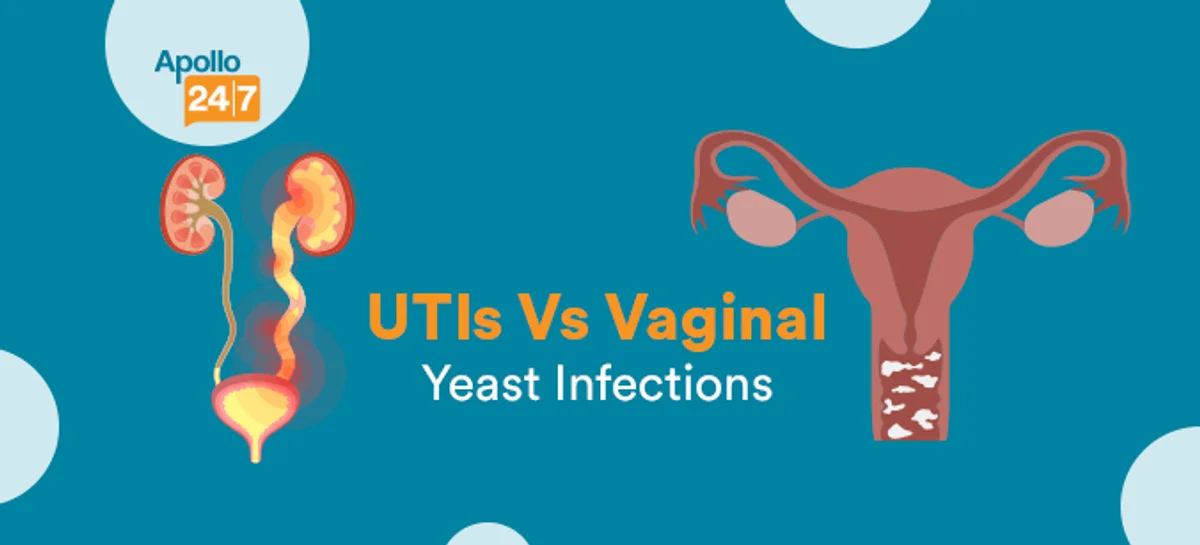- Home
- Blog
- Women Care
UTIs Vs Vaginal Yeast Infection: What's The Difference and How to Prevent them?
Women Care
UTIs Vs Vaginal Yeast Infection: What's The Difference and How to Prevent them?
By Apollo 24|7, Published on- 16 August 2022, Updated on -18 October 2022
Share this article
0
0 like

Women often experience pain, burning sensation, itching, and discomfort while urinating, all of which are signs of both urinary tract infections (UTI) and vaginal yeast infections. However, due to similarities in symptoms, one may not know which infection they are suffering from. Read the article below to know the differences, causes, and ways to prevent both urinary tract infections and vaginal yeast infections.
What is a UTI?
A urinary tract infection (UTI) occurs when bacteria such as Escherichia coli, Klebsiella pneumonia, Staphylococcus saprophyticus, enter the urinary tract and multiply. According to the National Kidney Foundation, one in five women get a UTI every year. Women are more prone to UTI infections than men because they have a shorter urethra (the tube through which urine passes out of the body). Moreover, when UTIs go untreated, there is a high risk of the infection spreading to the bladder and kidneys, which can, sometimes, result in irreversible damage.
Symptoms of UTI
- Frequent urge to urinate
- Pain while passing urine
- Burning sensation
- Strong foul odour
- Cloudy urine
- Itching
To know how UTIs affect men, women, and children, watch this video by Dr. Vikram Shah Batra, Sr. Urologist with Apollo 24|7.
How is UTI Treated?
Urinary tract infections are usually treated with antibiotics that kill bacteria and flush out the infection. Some commonly used antibiotics can include:
- Nitrofurantoin
- Sulphonamides
- Amoxicillin
- Cephalosporins
- Trimethoprim/sulfamethoxazole
- Doxycycline
- Quinolones
It is essential to complete the entire course of antibiotics to prevent the recurrence of the infections. Therefore, even if the symptoms subside, one needs to adhere to the prescribed antibiotics.
What is a Vaginal Yeast Infection?
A vaginal yeast infection is a type of fungal infection caused by a fungus called candida. Candida is normally found in the body, however, when it grows to an abnormal level, an imbalance occurs. This results in discomfort, abnormal discharges, and inflammations in the female genital regions, such as the labia. It must be noted that women can also get vaginal yeast infections due to uncontrolled blood sugar levels, weakened immune systems, and during menopause and pregnancy.
Symptoms of Vaginal Yeast Infections
- Pain while urinating
- White discharges
- Swelling of genitals
- Itching
- Burning sensation
- Pain during sexual intercourse
Because of whatsoever reason, if you are experiencing any of the symptoms of vaginal yeast or UTI, consult our best urologist and avail safest UTI treatment. You can consult our expert obstetrician-gynecologist to undergo the most effective vaginal yeast infection treatment.
How are Vaginal Yeast Infections Treated?
For treating vaginal yeast infections, the doctor may recommend lab tests to identify the type of yeast that caused the infection. After tests, the doctor would prescribe an antifungal medication to tackle overgrowths of yeast in the body.
Antifungal medications are available in two forms: oral and topical. Oral medications are taken by the mouth, while topical medicines are applied to the affected area. Topical medications may include boric acid, nystatin, miconazole, or clotrimazole. In addition, your doctor will guide you on how to apply the medicines correctly for quick relief and reduced chances of recurrence.
Can You Have Both UTI and Vaginal Yeast Infection Together?
Although UTIs and vaginal yeast infections occur due to different microorganisms, one can have them together or consecutively. Research suggests that while treating UTIs with antibiotics, there can be yeast growth due to the killing of healthy bacteria, leading to vaginal yeast infections.
How Can You Prevent Recurring UTIs and Vaginal Yeast Infections?
One can usually prevent UTIs and yeast infections or vaginal thrush symptoms with minor lifestyle changes.
1. Practice good hygiene
Washing your genital region with a PH-friendly wash twice a day can help you stay away from UTIs and yeast infections. Most importantly washing from front to back and not from back to front can keep bacteria from entering the vagina.
2. Drink plenty of fluids and cranberry juice
Keep your body hydrated adequately throughout the day. Drink at least 8 glasses of water to flush out bacteria and yeast from the body. Additionally, cranberry juice is highly effective in preventing as well as treating UTIs.
3.Dip your undergarments in an antiseptic solution
If you are experiencing recurring UTIs and yeast infections, it is advisable to dip your undergarments in an antiseptic solution overnight to ensure that microorganisms do not return to the vaginal passage by wearing undergarments that are carrying the infection. One can also choose to throw out the undergarments and wear fresh ones to avoid the risk of re-infection, especially during pregnancy.
4. Cleaning genitals before and after sex
It has been observed that women tend to get UTIs after sex. Hence, it is recommended for both men and women to wash up right before and after sex to avoid catching the infection repeatedly.
5. Opting for alternative birth control methods
Birth control pills can interfere with the estrogen levels in the woman's body, which can cause UTI infections. If you are having birth control pills and experiencing bouts of UTIs and yeast infections. Consider speaking with your gynaecologist to suggest alternative methods of birth control.
6. Opting for water-based lubricant during sex
The use of lubricants has been associated with yeast infections. It is recommended to use water-based lubricants to minimise the risk of re-infection and ease pain during sexual intercourse.
7. Antibiotic resistance
Do not leave your medicine course halfway, doing so may lead to antibiotic resistance. Antibiotic drug resistance is a common reason why most men and women experience recurring UTIs. It has been observed that antibiotic drugs are many times discontinued in the mid-way which leads to severe reinfection. Hence, the doctor may prescribe a test to check for antibiotic resistance before prescribing you further antibiotics to treat UTIs.
Conclusion
Urinary tract infections and vaginal yeast infections are more common in women than men. Although both conditions respond well to treatments, they can recur if the entire course of antibiotics is not taken. Recurring UTIs can cause discomfort and irreversible damage to the kidneys and bladder. Hence, if you are experiencing recurrent bouts of infections, it is recommended to practice hygiene, drink plenty of fluids, and contact a nephrologist to relieve symptoms at the earliest.
Consult The Best Urologist for Safest UTI & Vaginal Yeast Infection Treatment
- Reviewed By Dr. Dhanunjay Reddy B
Services
Women Care
Leave Comment
Services
Recommended for you

Women Care
Can PCOS Affect Your Chances Of Getting Pregnant?
PCOS is one of the most common problems experienced by a large number of the female population in the world. It often impacts the chances of getting pregnant. Read on to understand the reason why it affects your chances of getting pregnant.

Women Care
8 Steps for Woman's Personal Care Regimen
There is no shortcut to success. The same applies to skincare and hair care. Even though you apply makeup and hair styling products, the problems will pop out. So, follow a minimalistic approach to a woman’s personal care regimen. #ApolloPharmacy #WithHerAtEveryStage #Skincare #HairCare #PersonalCareRegimen

Women Care
5 Best Ways to Help Ease Leg Cramps During Pregnancy
Hormonal changes, gaining weight, back pain, and leg cramps are just some of the difficulties a pregnant woman faces. Our medical experts have created a list of the top 5 easy hacks to help pregnant women cope with the agony of leg cramps. Check out this blog now!
Subscribe
Sign up for our free Health Library Daily Newsletter
Get doctor-approved health tips, news, and more.

